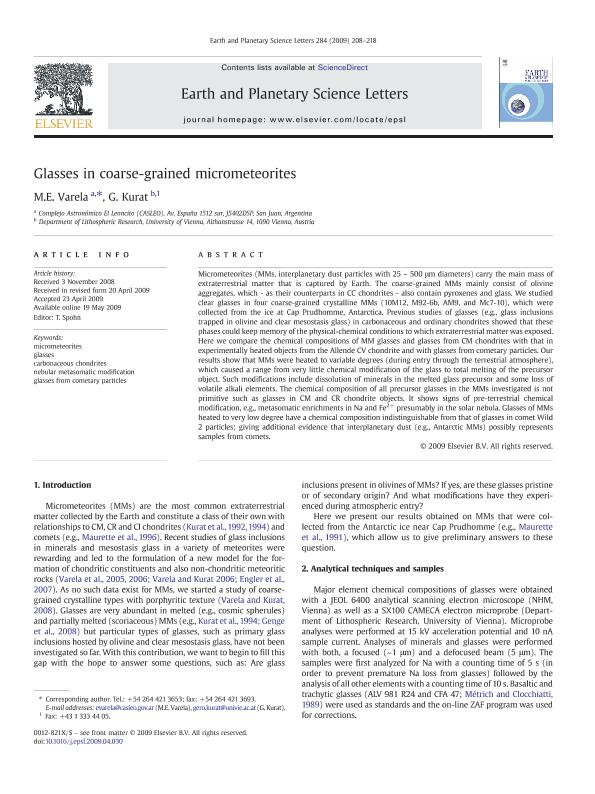Mostrar el registro sencillo del ítem
dc.contributor.author
Varela, Maria Eugenia

dc.contributor.author
Kurat, G.
dc.date.available
2023-09-19T14:32:02Z
dc.date.issued
2009-06
dc.identifier.citation
Varela, Maria Eugenia; Kurat, G.; Glasses in coarse-grained micrometeorites; Elsevier Science; Earth and Planetary Science Letters; 284; 1-2; 6-2009; 208-218
dc.identifier.issn
0012-821X
dc.identifier.uri
http://hdl.handle.net/11336/212058
dc.description.abstract
Micrometeorites (MMs, interplanetary dust particles with 25 - 500 μm diameters) carry the main mass of extraterrestrial matter that is captured by Earth. The coarse-grained MMs mainly consist of olivine aggregates, which - as their counterparts in CC chondrites - also contain pyroxenes and glass. We studied clear glasses in four coarse-grained crystalline MMs (10M12, M92-6b, AM9, and Mc7-10), which were collected from the ice at Cap Prudhomme, Antarctica. Previous studies of glasses (e.g., glass inclusions trapped in olivine and clear mesostasis glass) in carbonaceous and ordinary chondrites showed that these phases could keep memory of the physical-chemical conditions to which extraterrestrial matter was exposed. Here we compare the chemical compositions of MM glasses and glasses from CM chondrites with that in experimentally heated objects from the Allende CV chondrite and with glasses from cometary particles. Our results show that MMs were heated to variable degrees (during entry through the terrestrial atmosphere), which caused a range from very little chemical modification of the glass to total melting of the precursor object. Such modifications include dissolution of minerals in the melted glass precursor and some loss of volatile alkali elements. The chemical composition of all precursor glasses in the MMs investigated is not primitive such as glasses in CM and CR chondrite objects. It shows signs of pre-terrestrial chemical modification, e.g., metasomatic enrichments in Na and Fe2+ presumably in the solar nebula. Glasses of MMs heated to very low degree have a chemical composition indistinguishable from that of glasses in comet Wild 2 particles; giving additional evidence that interplanetary dust (e.g., Antarctic MMs) possibly represents samples from comets. © 2009 Elsevier B.V. All rights reserved.
dc.format
application/pdf
dc.language.iso
eng
dc.publisher
Elsevier Science

dc.rights
info:eu-repo/semantics/openAccess
dc.rights.uri
https://creativecommons.org/licenses/by-nc-sa/2.5/ar/
dc.subject
CARBONACEOUS CHONDRITES
dc.subject
GLASSES
dc.subject
GLASSES FROM COMETARY PARTICLES
dc.subject
MICROMETEORITES
dc.subject
NEBULAR METASOMATIC MODIFICATION
dc.subject.classification
Otras Ciencias Naturales y Exactas

dc.subject.classification
Otras Ciencias Naturales y Exactas

dc.subject.classification
CIENCIAS NATURALES Y EXACTAS

dc.title
Glasses in coarse-grained micrometeorites
dc.type
info:eu-repo/semantics/article
dc.type
info:ar-repo/semantics/artículo
dc.type
info:eu-repo/semantics/publishedVersion
dc.date.updated
2023-07-07T20:32:22Z
dc.journal.volume
284
dc.journal.number
1-2
dc.journal.pagination
208-218
dc.journal.pais
Países Bajos

dc.journal.ciudad
Amsterdam
dc.description.fil
Fil: Varela, Maria Eugenia. Consejo Nacional de Investigaciones Científicas y Técnicas. Centro Científico Tecnológico Conicet - San Juan. Complejo Astronómico "El Leoncito". Universidad Nacional de Córdoba. Complejo Astronómico "El Leoncito". Universidad Nacional de la Plata. Complejo Astronómico "El Leoncito". Universidad Nacional de San Juan. Complejo Astronómico "El Leoncito"; Argentina
dc.description.fil
Fil: Kurat, G.. Universidad de Viena; Austria
dc.journal.title
Earth and Planetary Science Letters

dc.relation.alternativeid
info:eu-repo/semantics/altIdentifier/url/https://www.sciencedirect.com/science/article/pii/S0012821X0900257X
dc.relation.alternativeid
info:eu-repo/semantics/altIdentifier/doi/http://dx.doi.org/10.1016/j.epsl.2009.04.030
Archivos asociados
